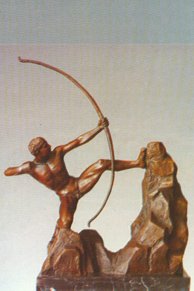Krakaca: 13 definitions
Introduction:
Krakaca means something in Hinduism, Sanskrit, Marathi. If you want to know the exact meaning, history, etymology or English translation of this term then check out the descriptions on this page. Add your comment or reference to a book if you want to contribute to this summary article.
Alternative spellings of this word include Krakacha.
In Hinduism
Dhanurveda (science of warfare)
Source: Wisdom Library: DhanurvedaKrakaca (क्रकच) refers to a weapon (“saw”). It is a Sanskrit word defined in the Dhanurveda-saṃhitā, which contains a list of no less than 117 weapons. The Dhanurveda-saṃhitā is said to have been composed by the sage Vasiṣṭha, who in turn transmitted it trough a tradition of sages, which can eventually be traced to Śiva and Brahmā.

Dhanurveda (धनुर्वेद) refers to the “knowledge of warfare” and, as an upaveda, is associated with the Ṛgveda. It contains instructions on warfare, archery and ancient Indian martial arts, dating back to the 2nd-3rd millennium BCE.
Languages of India and abroad
Marathi-English dictionary
Source: DDSA: The Molesworth Marathi and English Dictionarykrakaca (क्रकच).—m n S A saw.
Source: DDSA: The Aryabhusan school dictionary, Marathi-Englishkrakaca (क्रकच).—m n A saw.
Marathi is an Indo-European language having over 70 million native speakers people in (predominantly) Maharashtra India. Marathi, like many other Indo-Aryan languages, evolved from early forms of Prakrit, which itself is a subset of Sanskrit, one of the most ancient languages of the world.
Sanskrit dictionary
Source: DDSA: The practical Sanskrit-English dictionaryKrakaca (क्रकच).—
1) A saw; Uttararāmacarita 4.3; Mv.5.19.
2) A kind of instrument of war music (jayamaṅgala); Mahābhārata (Bombay) 6.43.8; क्रकचानां काहलानां पणवानां च सर्वशः (krakacānāṃ kāhalānāṃ paṇavānāṃ ca sarvaśaḥ) Śiva B.24.54.
-cā The Ketaka tree.
Derivable forms: krakacaḥ (क्रकचः).
Source: Cologne Digital Sanskrit Dictionaries: Shabda-Sagara Sanskrit-English DictionaryKrakaca (क्रकच).—mn.
(-caḥ-caṃ) 1. A saw. 2. A thorny plant: see karīra. f.
(-cā) The Ketaki: see the next. E. kra an imitative sound, kac to emit sound, affix ac.
Source: Cologne Digital Sanskrit Dictionaries: Benfey Sanskrit-English DictionaryKrakaca (क्रकच).— (base krak, an imitative sound), m. and n. A saw, Mahābhārata 3, 882.
Source: Cologne Digital Sanskrit Dictionaries: Cappeller Sanskrit-English DictionaryKrakaca (क्रकच).—[masculine] [neuter] a saw.
Source: Cologne Digital Sanskrit Dictionaries: Monier-Williams Sanskrit-English Dictionary1) Krakaca (क्रकच):—mn. a saw, [Mahābhārata] etc.
2) m. a kind of musical instrument, [Mahābhārata vii, 1676; ix, 2676]
3) Ardea virgo, [Nighaṇṭuprakāśa]
4) Name of a plant (Capparis aphylla, [cf. Lexicographers, esp. such as amarasiṃha, halāyudha, hemacandra, etc.]), [Kādambarī]
5) of a hell, [Padma-purāṇa]
6) of a Kāpālika priest, [Saṃkṣepa-śaṃkara-vijaya]
7) Krakacā (क्रकचा):—[from krakaca] f. = -cchada, [cf. Lexicographers, esp. such as amarasiṃha, halāyudha, hemacandra, etc.]
Source: Cologne Digital Sanskrit Dictionaries: Yates Sanskrit-English DictionaryKrakaca (क्रकच):—[(caḥ-caṃ)] 1. m. n. A saw; a thorny plant (Pandanus).
Source: DDSA: Paia-sadda-mahannavo; a comprehensive Prakrit Hindi dictionary (S)Krakaca (क्रकच) in the Sanskrit language is related to the Prakrit word: Karakaya.
[Sanskrit to German]
Sanskrit, also spelled संस्कृतम् (saṃskṛtam), is an ancient language of India commonly seen as the grandmother of the Indo-European language family (even English!). Closely allied with Prakrit and Pali, Sanskrit is more exhaustive in both grammar and terms and has the most extensive collection of literature in the world, greatly surpassing its sister-languages Greek and Latin.
Kannada-English dictionary
Source: Alar: Kannada-English corpusKrakaca (ಕ್ರಕಚ):—
1) [noun] a cutting tool, of various shapes and sizes and worked by hand or machinery, consisting essentially of a thin blade or disk of metal, usu. steel, the edge of which is a series of sharp teeth; a saw.
2) [noun] (myth.) name of a hell.
--- OR ---
Krakaca (ಕ್ರಕಚ):—
1) [noun] the tree Pandanus fascicularis ( = P. odoratissimus, = P. tectorius) of Pandanaceae family; screw pine tree.
2) [noun] its flower.
Kannada is a Dravidian language (as opposed to the Indo-European language family) mainly spoken in the southwestern region of India.
See also (Relevant definitions)
Starts with: Krakacacchada, Krakacanasika, Krakacapad, Krakacapada, Krakacapatra, Krakacapattra, Krakacaprishthi, Krakacatvac, Krakacavidarana, Krakacavyavahara.
Ends with: Anukrakaca.
Full-text (+6): Anukrakaca, Krakacaprishthi, Krakacika, Krakacapad, Krakacacchada, Krakacavyavahara, Krakara, Krakacatvac, Krakacyavyavahriti, Krakacapattra, Krakace, Krakacya, Kirakacam, Karakaya, Anukakaca, Krakacapatra, Krakacapada, Vatarayana, Ardha-pataka, Kacanem.
Relevant text
Search found 10 books and stories containing Krakaca, Krakacā; (plurals include: Krakacas, Krakacās). You can also click to the full overview containing English textual excerpts. Below are direct links for the most relevant articles:
Jivanandana of Anandaraya Makhin (Study) (by G. D. Jayalakshmi)
Sannipātas (fevers due to Vāta, Pitta and Kapha) < [Chapter 4 - Āyurvedic principles in Jīvanandana Nāṭaka]
Act II (Summary) < [Chapter 3 - Summary of the Play Jīvānandana Nāṭaka]
Vasudevavijaya of Vasudeva (Study) (by Sajitha. A)
Tatpuruṣa-samāsa (Compound) < [Chapter 3 - Vāsudevavijaya—A Grammatical Study]
The Padma Purana (by N.A. Deshpande)
Chapter 114 - The Seven Hells Shown to Dhaneśvara < [Section 6 - Uttara-Khaṇḍa (Concluding Section)]
The Skanda Purana (by G. V. Tagare)
Chapter 92 - The Greatness of Yamahāsya Tīrtha < [Section 3 - Revā-khaṇḍa]
Chapter 225 - Greatness of Anarakeśvara (Anaraka-īśvara) < [Section 1 - Prabhāsa-kṣetra-māhātmya]
Chapter 68 - Piśāceśvara (piśāca-īśvara-liṅga) < [Section 2 - Caturaśīti-liṅga-māhātmya]
The Agni Purana (by N. Gangadharan)
The Shiva Purana (by J. L. Shastri)
Chapter 8 - Description of the Hell (naraka) < [Section 5 - Umā-Saṃhitā]